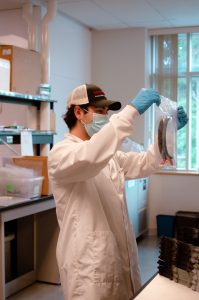After the impact of the COVID-19 pandemic began to be fully realized, and shortages in PPE for medical professionals around the world became painfully apparent, new initiatives for locally sourced and produced supplements to the industry began to pop up. Here in Victoria, BC, the main hub for this began in the Willerth Laboratory at UVic. To get the initiative off the ground Coast Capital Savings donated a generous amount of $10,000. In addition, there was support from UVic Co-op and Career Services, Coast Capital Savings Innovation Centre, Technation, Innovate BC, UVic BME and New Venture BC to hire summer co-op students to work on the development of PPE. The community quickly pivoted to make this initiative come to life, and the UVic Engineering COVID-19 Response Team was founded. Co-ordination quickly began to start production of 3D printed face shields for the community. As well as collecting donated parts from local individuals with personal 3D printers, they have a lab full of their own 3D printers as the primary production line. All of the face shields being produced are donated to Island Health at no cost, as well as to a variety of family doctors throughout Vancouver Island.
The face shields are made up of four main parts: headband, shield, shield reinforcement, and elastic.
The headbands are the most complicated part to produce. They are 3D printed, both at UVic and by various generous members of the community. The 3D printer lab at the UVic Engineering Lab Wing currently has 9 Ultimaker printers running  around the clock, to churn the headbands out as quickly as possible.
around the clock, to churn the headbands out as quickly as possible.
After the headbands are printed, they need to go through a rigorous testing and refining process. A rotating collection of 1-3 socially distancing co-op students separate each headband from the printed stack, smooth and sand off any rough edges or blemishes, and apply a load to make sure they are structurally sound. Health care professionals are going to be wearing the bands for hours at a time, so it is important to ensure they’re as comfortable as possible.
The elastic is much simpler to produce. While the design is constantly changing and being upgraded, the main idea stays the same. It has three tab endings that attach to the headband, and an adjustable backing connector. This allows the wearer to easily adjust the shield to fit snugly to their face as comfortably as possible. The main issue with this critical part is sourcing it: demand is high around the world, and that makes it hard to get reliably.
The shield is manufactured by a generous local business in Sidney, BC: Foreman CNC. They use a laser cutter to efficiently produce clear plastic shields with smooth edges and precise locating features for attachment to the headband. Again, the main hardship here is sourcing material. In a time when every establishment that is open has put up clear plastic barriers to protect their employees, it’s not hard to imagine that the supply of those materials is suddenly overwhelmed. The headband has had to be redesign once already to account for using a thicker shield than originally planned after the thinner one became impossible to acquire for a number of weeks.
After manufacturing, all of the parts are sent to the second lab for sterilization and packaging. Currently, the face shields are being assembled and sterilized in the Medical Sciences Building, within the Willerth Laboratory. The newly 3D printed headbands are sanitized via soap and water; then, laid out to dry. The visors, which are not manufactured on campus, are sterilized by wiping both faces with ethanol. After both pieces have been properly sterilized, they  are packaged into a transparent plastic bag along with the elastic band. In addition, to disinfect the kit further, the kits are each placed into an Ultraviolet sterilization cabinet for 15 minutes.
are packaged into a transparent plastic bag along with the elastic band. In addition, to disinfect the kit further, the kits are each placed into an Ultraviolet sterilization cabinet for 15 minutes.
Furthermore, the Victoria Hand Project and two co-op students are currently testing the tensile strength of 3D printed specimens after being exposed to varying sanitization methods. Methods include ethanol, isopropyl alcohol, hydrogen peroxide, and soap; all methods that are currently being used to disinfect face shields. This study’s results will display the ideal disinfectant for reusable face shields.
The process is ever changing, and the team is constantly making adjustments to accommodate new materials and improvements to fine-tune the design are occurring regularly. The objective evolves as the they continue to optimize the design of the three-part face shield. The question always being considered is: how can the design be improved to make the shields more easily produced, comfortable, and effective? Currently, new inserts are being produced that create a seal at the top of the visor, which further improves protection from airborne particles.
The team is managing to produce approximately 250 face shields per week at peak production, plus receiving approximately 100 donated community prints per week. To date, the team has been able to donate 2600 face shield kits to local medical professionals. With continued support from local donors and the community, they will be able to continue with this initiative as well as being prepared to provide for any new future demands in locally sourced PPE that may arise.
Written by Tal Katz (Willerth Lab Co-op Student) and Liz Bueckert.
